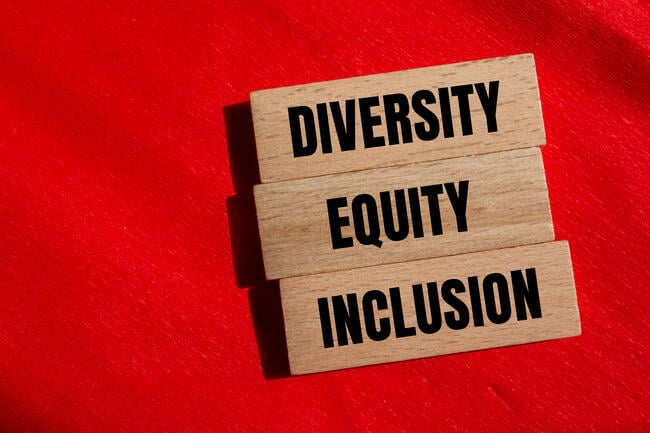You have /5 articles left.
Sign up for a free account or log in.

Emre Akkoyun/iStock/Getty Images Plus
When we talk about diversity, equity and inclusion in higher education, the discussion typically centers on the familiar red state–versus–blue state divide, suggesting that the ideological battles of the electorate have infiltrated the hallowed halls of the university. Yet, a new analysis of national faculty survey data that I led unearths a more intricate and arguably more profound fault line: that of academic discipline. It’s not just where faculty teach but what they teach that profoundly shapes their views on DEI and related issues of campus climate.
Funded by the Templeton Religion Trust, the InForm survey asked nearly 1,000 faculty members about their opinions on matters of university life, including about free speech, DEI and religion. Of the 977 usable responses, 22.8 percent came from faculty in education; 20.3 percent in social sciences; 19.5 percent in science, technology, engineering and mathematics; 18.6 percent in arts and humanities; 17.9 percent in business; and the remaining 0.9 percent were treated as missing data.
We weighted the data to represent national norms across various factors, including region, institutional control and institutional type. We performed analyses to find statistically significant differences between disciplines, with a magnitude of mean difference standardized from 0 (weak) to 1 (strong). To be clear, observations indicate significant differences between faculty of different disciplines on DEI measures, not an indication of DEI endorsement itself. In other words, business faculty may endorse DEI items but not to the same degree as faculty in education, for example.
Our analysis of the largest differences in faculty opinions uncovers startling divergences, particularly between business and education faculty. For instance, an astonishing 0.626 difference exists between these two groups in whether they agree with the statement “The promotion of diversity, equity and inclusion on college and university campuses has gone too far.” This is not a subtle disagreement; it’s a chasm, echoing broader national anxieties about the scope of DEI initiatives. Similarly, a 0.730 difference separates them on whether “Colleges and universities should continue to offer identity-specific organizations and programming,” with education faculty being overwhelmingly more supportive.
These significant gaps extend to fundamental questions about DEI’s impact: “Diversity programs generally do more harm than good on college and university campuses” sees a 0.607 difference between faculty in business and education. “The current efforts to ban campus diversity programs are well justified” shows a 0.548 difference. And “Banning campus diversity programs will negatively impact many students” reveals a 0.564 difference, with education faculty far more likely to agree it will have negative impacts. These numbers are not just statistics; they paint a vivid picture of two academic cultures operating with vastly different premises about the purpose and impact of DEI in higher education.
Education department curricula are frequently steeped in pedagogical theories that emphasize social justice, equity and inclusive learning environments. For faculty in these disciplines, DEI is not an optional add-on but an essential component of preparing students for a diverse world and addressing historical inequities within educational systems. Their work often involves grappling with societal challenges that demand a critical understanding of power dynamics and identity.
Business schools, while increasingly recognizing the importance of diverse workplaces, may traditionally prioritize different constructs and metrics: efficiency, profit, market competitiveness and individual achievement. While business-related fields are not inherently opposed to DEI—indeed, many businesses tout their commitment to diversity as a strategic asset—the framing and perceived utility of such programs may differ considerably from disciplines focused more specifically on social justice. This divergence is not necessarily intentional nor malicious, but speaks to distinct disciplinary epistemologies and priorities that shape how faculty may interpret and value DEI efforts.
Beyond business and education, significant differences in attitudes also emerge when comparing business with social sciences faculty, particularly concerning identity-specific programming and the justification of DEI bans. And arts, humanities and music faculty often align more closely with education and social sciences faculty in their strong support for diversity initiatives and their concerns about bans.
Within the broader discourse on religion, nuanced differences exist. While our previous analysis noted a general consensus on including religious, spiritual and secular diversity in DEI, the data shows a 0.535 difference between education and STEM faculty, with the latter more likely to agree that “Campuses should not concern themselves with religious, secular and spiritual diversity.” This suggests that even on areas of general agreement, the approach and emphasis on inclusion might vary by discipline, reflecting the distinct concerns and methodologies of fields from ethics to engineering.
These findings underscore a critical truth: The debate over DEI in the academy is not monolithic. It’s not merely a political skirmish imported onto campus. It’s also a reflection of deeply ingrained disciplinary perspectives, values and pedagogical philosophies.
Some in the academy might advocate for movement toward the ways professors in education and social sciences frame the values and goals of DEI; others may think that business faculty’s understanding of DEI should be more prioritized or considered. Still others may think that, when framed optimistically, the range of views on DEI serves as a defense against those who might perpetuate the myths concerning higher education indoctrination —if students, mostly through their general education requirements, are exposed to competing or varying perspectives on issues as politically contentious as DEI seems to represent, then the academy—arguably the best place for dialogue across difference—is doing its job.
To move forward constructively, universities must acknowledge these internal academic differences and lean into them as a potential advantage. How might higher education improve for students who are equipped with acute understandings and appreciations for DEI’s commitment to community and the skills needed to measure its effectiveness by way of productivity, efficiency and market competitiveness?
Instead of a uniform, top-down approach to DEI, understanding the specific concerns, priorities and benefits that resonate within each discipline will remain crucial for moving programs forward in the service of students from all backgrounds and beliefs. Bridging these disciplinary divides, alongside the political ones, is essential to fostering a vibrant academic community that serves all its students effectively.


